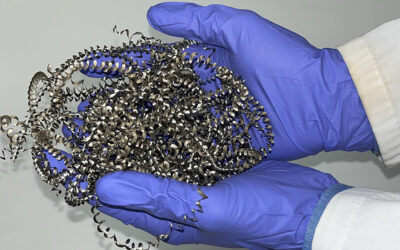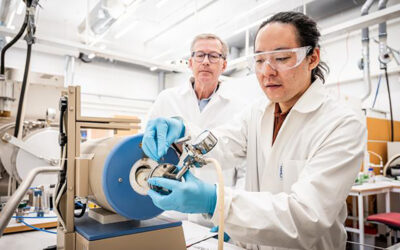Welcome to the latest selection of recent top articles in the physica status solidi journals. Get a glimpse of our publication spectrum and visit our pages by clicking on any of the DOI links below.
Theoretical investigation of molecular and electronic structure changes of the molecular magnet Mn12 cluster upon super-reduction [Rapid Research Letter]
Yoshio Nishimoto, Hirofumi Yoshikawa, Kunio Awaga, Marcus Lundberg, and Stephan Irle
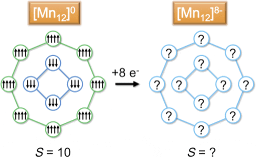 Theoretical studies based on density functional theory (DFT) describe the changes in molecular and electronic structures during the super-reduction of the Mn12 cluster by the uptake of eight excess electrons in the gas phase. The results agree largely with experimental observations obtained in a molecular cluster battery setup.
Theoretical studies based on density functional theory (DFT) describe the changes in molecular and electronic structures during the super-reduction of the Mn12 cluster by the uptake of eight excess electrons in the gas phase. The results agree largely with experimental observations obtained in a molecular cluster battery setup.
Phys. Status Solidi RRL (2014) DOI 10.1002/pssr.201409094
Study of charged defects for substitutionally doped chromium in hexagonal barium titanate from first-principles theory [Rapid Research Letter]
Sanjeev K. Nayak, Waheed A. Adeagbo, Hans T. Langhammer, Wolfram Hergert, Thomas Müller, and Rolf Böttcher
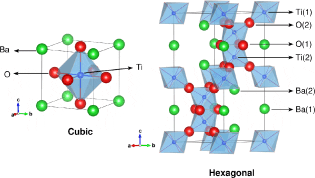 Defect properties and charge states of Cr doped BaTiO3 are studied for the hexagonal structure using density functional theory and applying post-processing corrections. While the cubic BaTiO3 contains one formula unit per unit cell, six formula units are necessary to describe the hexagonal BaTiO3. Cr is found to occupy the Ti sites and has a charge state of –1 (Cr3+ in ionic model), which is valid for a wide range of growth conditions in agreement with experimental results.
Defect properties and charge states of Cr doped BaTiO3 are studied for the hexagonal structure using density functional theory and applying post-processing corrections. While the cubic BaTiO3 contains one formula unit per unit cell, six formula units are necessary to describe the hexagonal BaTiO3. Cr is found to occupy the Ti sites and has a charge state of –1 (Cr3+ in ionic model), which is valid for a wide range of growth conditions in agreement with experimental results.
Phys. Status Solidi RRL (2014) DOI 10.1002/pssr.201409032
Nanotube film metallicity and its effect on the performance of carbon nanotube–silicon solar cells [Advanced Materials Physics]
Daniel D. Tune, Adam J. Blanch, Ralph Krupke, Benjamin S. Flavel, and Joseph G. Shapter
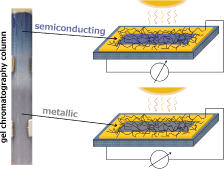 Using highly pure semiconducting and metallic carbon nanotubes, film metallicity is shown to be a vital factor in the performance of carbon nanotube–silicon solar cells. Metallic nanotubes greatly outperform their semiconducting counterparts unless the films are doped, in which case the difference is reduced but still significant.
Using highly pure semiconducting and metallic carbon nanotubes, film metallicity is shown to be a vital factor in the performance of carbon nanotube–silicon solar cells. Metallic nanotubes greatly outperform their semiconducting counterparts unless the films are doped, in which case the difference is reduced but still significant.
Phys. Status Solidi A (2014) DOI 10.1002/pssa.201431043
Low temperature thermally stimulated currents characterization of nanoporous TiO2 films [Invited Article]
Mara Bruzzi, Riccardo Mori, Ennio Carnevale, Monica Scaringella, and Franco Bogani
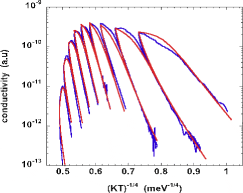 The role of localized states in electrical conductivity on nanocrystalline TiO2 for dye sensitized solar cells (DSSCs) has been investigated by thermally stimulated current (TSC) measurements. The theoretical analysis of TSCs in a heavily disordered medium is a quite complex phenomenon. The authors have outlined a procedure of numerical simulation that allows for the extraction of significant parameters, as density of defect states and value of the energy constant of the exponential band-tail distribution. The study shows that in a quasi-equilibrium regime, main conduction mechanism in nc-TiO2 is due to hopping, rather than to free carriers that undergo multi-trapping processes.
The role of localized states in electrical conductivity on nanocrystalline TiO2 for dye sensitized solar cells (DSSCs) has been investigated by thermally stimulated current (TSC) measurements. The theoretical analysis of TSCs in a heavily disordered medium is a quite complex phenomenon. The authors have outlined a procedure of numerical simulation that allows for the extraction of significant parameters, as density of defect states and value of the energy constant of the exponential band-tail distribution. The study shows that in a quasi-equilibrium regime, main conduction mechanism in nc-TiO2 is due to hopping, rather than to free carriers that undergo multi-trapping processes.
Phys. Status Solidi A (2014) DOI 10.1002/pssa.201330608
Magnetoelastic coupling and the formation of adaptive martensite in magnetic shape memory alloys [Feature Article]
Markus Ernst Gruner, Sebastian Fähler, and Peter Entel
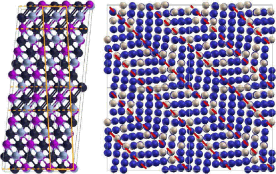 Based on the results of recent first-principles calculations, Gruner et al. review the role of modulated or adaptive martensites in magnetic shape memory alloys. The authors work out an analogy between two paradigmatic materials classes, Ni2MnGa and Fe70P30, and demonstrate that in both cases the low formation energy for tetragonal twins opens an alternative transformation path which allows the evolution of a functional hierarchical microstructure upon cooling. In turn, finite temperature magnetic disorder destabilizes modulation and adaptive martensite in favor of the cubic austenite pointing out the strong impact of magnetoelastic interactions on the transformation process.
Based on the results of recent first-principles calculations, Gruner et al. review the role of modulated or adaptive martensites in magnetic shape memory alloys. The authors work out an analogy between two paradigmatic materials classes, Ni2MnGa and Fe70P30, and demonstrate that in both cases the low formation energy for tetragonal twins opens an alternative transformation path which allows the evolution of a functional hierarchical microstructure upon cooling. In turn, finite temperature magnetic disorder destabilizes modulation and adaptive martensite in favor of the cubic austenite pointing out the strong impact of magnetoelastic interactions on the transformation process.
Phys. Status Solidi B (2014) DOI 10.1002/pssb.201350397
Electron waveguide interferometers for spin-dependent transport experiments [Feature Article]
Olivio Chiatti, Sven S. Buchholz, Ulrich Kunze, Dirk Reuter, Andreas D. Wieck, and Saskia F. Fischer
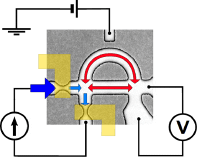 This Feature Article presents the state-of-the-art of quasi-one-dimensional quantum point contacts, electron waveguide structures and Aharonov–Bohm interferometers, fabricated in GaAs/AlGaAs heterostructures. Coherent low-temperature transport and interference effects are studied in- and out-of-equilibrium. In particular, in the non-linear transport regime, correlations of spin-fluctuations may become important with respect to many-body corrections of the quasi-one-dimensional potential. Coherent mode-filtered injection of electrons into a few-mode interferometer is demonstrated. These results encourage the investigation of spin-dependent quantum transport in extended electron waveguide interferometers, in (sub-)single or few mode operation.
This Feature Article presents the state-of-the-art of quasi-one-dimensional quantum point contacts, electron waveguide structures and Aharonov–Bohm interferometers, fabricated in GaAs/AlGaAs heterostructures. Coherent low-temperature transport and interference effects are studied in- and out-of-equilibrium. In particular, in the non-linear transport regime, correlations of spin-fluctuations may become important with respect to many-body corrections of the quasi-one-dimensional potential. Coherent mode-filtered injection of electrons into a few-mode interferometer is demonstrated. These results encourage the investigation of spin-dependent quantum transport in extended electron waveguide interferometers, in (sub-)single or few mode operation.
Phys. Status Solidi B (2014) DOI 10.1002/pssb.201350229














